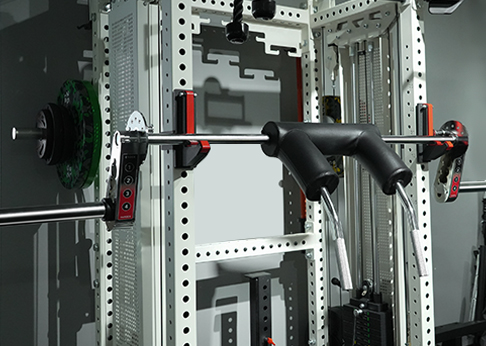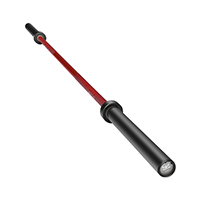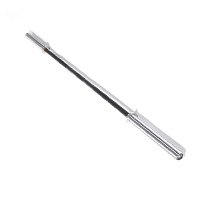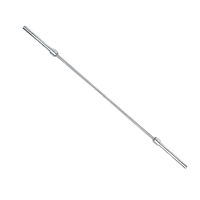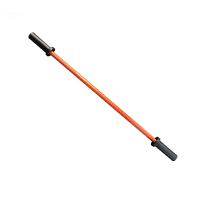Special Barbell
Purchase Special Barbell for Strength Training – Weightlifting
The Special Barbell is a meticulously engineered strength training tool designed for athletes and fitness enthusiasts who prioritize high performance and durability. Featuring a comprehensive production process that ensures quality at every stage, this barbell incorporates a zero-gap design between the bar shaft and sleeves, providing optimal performance and stability. The sleeve rotation speed can be customized based on user requirements, ensuring a smooth and efficient lifting experience.
Quality control is paramount, supported by an independent testing laboratory overseeing all production aspects. The bar shaft undergoes precision machining to eliminate scratches, with the knurling depth carefully controlled to provide an optimal grip. Various patterns can be printed on the barbell, enhancing customization options. Built to withstand significant weight and fatigue, the Special Barbell offers durable construction that ensures longevity while focusing on safety and environmental sustainability.
The manufacturing process begins with high-quality raw materials, typically starting at a diameter of 29 mm and processed to achieve a final diameter of 28.5 mm. Straightening corrects any curvature, followed by rough machining to shape the barbell. Heat treatment enhances tensile strength, load-bearing capacity, and elasticity, while secondary straightening minimizes distortion. The barbell is ground three times for improved surface smoothness and polished to achieve a shiny finish. Surface treatments include electroplating, Teflon coating, hard chrome, black chrome, and spray painting, with QBQ coating used for added durability.
During assembly, bronze bushings and bearings are used, and lubrication is applied to ensure smooth operation. Anti-rust oil is carefully applied to prevent corrosion. The Special Barbell blends advanced technology and quality craftsmanship, making it a valuable addition to any gym. It effectively meets consumer needs while performing reliably under heavy loads, helping users achieve their strength training goals.
Enhance your gym routine with Leadman Fitness specialty barbells, designed for versatility and precision targeting of specific muscle groups. Whether you’re powering through deadlifts with an open trap bar, performing squats with a safety squat bar, or isolating muscles with a curl or triceps bar, these specialty weightlifting barbells bring focus to your routine. Shop Leadman Fitness for top specialty bars, where quality is guaranteed. Special barbells from Leadman Fitness are designed for all fitness levels, offering Olympic, weightlifting, and adjustable options to boost strength.
Special Barbell Weightlifting
Standard Weights of Special Barbells
Special barbells come in various designs and weights, each tailored for specific lifting purposes. Here are some common examples of special barbells and their typical weights:
Safety Squat Bar:
The safety squat bar usually weighs around 55 lbs (25 kg). Its design features padded shoulders, handles, and a safety squat bar strap, allowing lifters to maintain an upright torso while squatting. Additionally, squat bar clips help secure the weight plates in place, ensuring stability and safety during the lift. This bar is particularly beneficial for those with shoulder or wrist issues, as it reduces the strain associated with traditional barbell squats.
Cambered Bar:
Cambered bars typically weigh between 35 lbs (16 kg) and 55 lbs (25 kg). The unique shape of this bar allows for deeper squats by shifting the center of gravity. This design can enhance muscle engagement in the posterior chain, particularly the glutes and hamstrings.
Trap Bar:
The trap bar, often used for deadlifts, generally weighs around 45 lbs (20 kg). This barbell allows lifters to stand inside the frame, providing a more natural lifting position. The weight distribution of the trap bar can help reduce lower back strain, making it an excellent choice for lifters of all experience levels. The trap bar lift, with its unique design, ensures a safer and more efficient lifting technique, promoting better posture and reducing the risk of injury.
Choosing the Right Weight
Selecting the appropriate weight for special barbells is essential for maximizing workout effectiveness and ensuring safety. Here are some tips to help you choose the right weight based on individual fitness levels and goals:
Assess Your Fitness Level:
Beginners should start with lighter weights to focus on mastering proper form and technique. Using a 15 lb or 25 lb special barbell can help develop muscle memory without the risk of injury. As confidence and strength build, lifters can gradually increase the weight.
Identify Your Goals:
Different training goals may require different approaches to weight selection. For instance, if your goal is to increase muscle size, you may want to choose a weight that allows you to perform 6-12 repetitions with good form. Conversely, if your focus is on building strength, selecting a weight that limits you to 1-5 repetitions may be more beneficial.
Consider Progressive Overload:
Progressive overload is key to continued strength gains and muscle development. Once you can comfortably lift a certain weight for the desired number of repetitions, it’s time to increase the load. For special barbells, this could mean adding small increments of weight or transitioning to a heavier barbell that still allows you to maintain proper form.
Use Technique Plates:
When starting with special barbells, consider using technique plates that are lighter and smaller in diameter. This allows for easy weight adjustments while still enabling you to practice the lift effectively.
Special Barbell Exercises
Common Exercises Using Special Barbells
Special barbells are designed to accommodate various exercises that target specific muscle groups while providing unique advantages in terms of form and function. Here are some common exercises performed with special barbells:
The trap bar deadlift is a popular exercise that allows lifters to stand inside a hexagonal frame, lifting from a more upright position. This setup shifts the center of gravity closer to the body, reducing strain on the lower back and enhancing overall stability. To perform a trap bar deadlift, stand in the center of the bar with your feet shoulder-width apart. Bend at the hips and knees to grip the handles, ensuring your back is straight and your core is engaged. As you lift, drive through your heels and extend your hips and knees simultaneously, keeping the bar close to your body. Benefits of this exercise include improved muscle activation in the glutes and hamstrings, a lower risk of injury, and a more accessible movement pattern for beginners.
The safety squat bar features padded shoulders and handles, which allow lifters to maintain an upright posture during squats. This bar is particularly beneficial for individuals with shoulder or back issues, as it alleviates strain on these areas compared to traditional back squats. To perform a squat with a safety squat bar, position the bar on your upper back and secure the handles. Stand with your feet shoulder-width apart, and as you descend into the squat, keep your chest up and your back straight. The design of the safety squat bar promotes proper squat depth and form, making it a great option for lifters looking to improve their squatting technique while reducing discomfort.
The cambered bar bench press features a unique design that allows the bar to rest lower than standard bars, promoting a greater range of motion during the press. This can lead to increased activation of the chest, shoulders, and triceps. To perform the cambered bar bench press, lie flat on a bench with your feet planted on the ground. Grip the cambered bar slightly wider than shoulder-width and lower it to your chest while keeping your elbows at a 45-degree angle. Press the bar back to the starting position while focusing on squeezing the chest muscles. This exercise not only enhances muscle engagement but also provides a different stimulus compared to traditional bench presses.
Benefits of Using Special Barbells
Incorporating special barbells into your training routine can yield numerous benefits, making them a valuable addition to any workout program:
Special barbells are designed to isolate specific muscle groups effectively. For instance, the trap bar can enhance the engagement of the posterior chain, while the safety squat bar can emphasize quad development. By utilizing different special barbells, lifters can tailor their workouts to meet their specific strength training goals and address muscle imbalances.
Many special barbells offer unique designs that enhance stability during lifts. For example, the wider grip options on multi-grip bars allow lifters to find a comfortable position that can improve balance and control. This stability is particularly beneficial for complex movements, as it allows for better focus on lifting mechanics.
Special barbells provide various grip and stance options, enabling lifters to perform exercises in ways that suit their body mechanics. This customization can lead to better engagement of target muscles and can help prevent overuse injuries caused by repetitive movements.
The design of special barbells often promotes better lifting mechanics, which can significantly reduce the risk of injury. For instance, the safety squat bar allows for a more natural squat position, which can help prevent knee and back injuries. Additionally, the use of lighter special barbells for practice can facilitate proper technique, ensuring that lifters develop safe habits before moving to heavier weights.
Special Barbell Workouts
Creating a Special Barbell Workout Routine
Incorporating special barbells into your workout routine can enhance your strength training experience and target specific muscle groups effectively. Here are some guidelines to help you create a comprehensive workout program:
Warm-Up Exercises:
Begin each workout with a proper warm-up to prepare your muscles and joints for lifting. A warm-up might include dynamic stretches, mobility exercises, and light cardio to increase blood flow. Consider performing exercises such as bodyweight squats, lunges, and arm circles for 5-10 minutes to activate your muscles and reduce the risk of injury.
Incorporating Special Barbells:
Design your workout routine to include a variety of exercises utilizing special barbells. Aim for a balanced program that targets major muscle groups. Here’s a sample workout routine:
Full-Body Strength Training Routine:
Trap Bar Deadlifts: 3 sets of 8-10 reps
Focus on proper form and gradually increase weight.
Safety Squat Bar Squats: 3 sets of 8-10 reps
Emphasize depth and control throughout the movement.
Cambered Bar Bench Press: 3 sets of 8-10 reps
Maintain a steady pace and ensure a full range of motion. For a different variation, try using a short bench press bar, which offers a more compact grip.
Specialized Curl Bar Bicep Curls: 3 sets of 10-12 reps
Use a comfortable grip to target the biceps effectively.
Farmers Walk with Trap Bar: 3 sets for distance or time
Focus on maintaining posture while carrying the weight.
Cool-Down Exercises:
After your workout, it’s essential to cool down to aid recovery and flexibility. Spend 5-10 minutes performing static stretches targeting the muscles worked during your session. Stretch your hamstrings, quadriceps, chest, and shoulders to help improve flexibility and reduce soreness.
Benefits of Special Barbell Workouts
Engaging in workouts that incorporate special barbells can lead to several significant benefits:
Improved Muscle Development:
Special barbells are designed to engage specific muscle groups more effectively than standard barbells. For example, the trap bar focuses on the posterior chain, while the safety squat bar emphasizes quad strength. This targeted approach helps build muscle in specific areas, contributing to overall strength and aesthetics.
Functional Strength Gains:
Many special barbell exercises mimic movements used in daily life and various sports, leading to improved functional strength. By using special barbells, lifters can enhance their ability to perform everyday activities, such as lifting heavy objects or climbing stairs, with greater ease and efficiency.
Varied Lifting Techniques:
Utilizing different special barbells introduces variety into workouts, which can prevent plateaus and keep training sessions engaging. Varied lifting techniques also challenge the muscles in new ways, promoting adaptation and growth. This variety can enhance overall fitness and athletic performance by improving strength, stability, and coordination.
Reduced Injury Risk:
Special barbells often promote better lifting mechanics and allow for a more natural range of motion. This emphasis on proper form reduces the risk of injury, particularly for those new to weightlifting or those recovering from previous injuries. By using special barbells, lifters can develop safe habits that carry over to their training with heavier weights.
Comprehensive Guide to Purchasing the Right Special Barbell
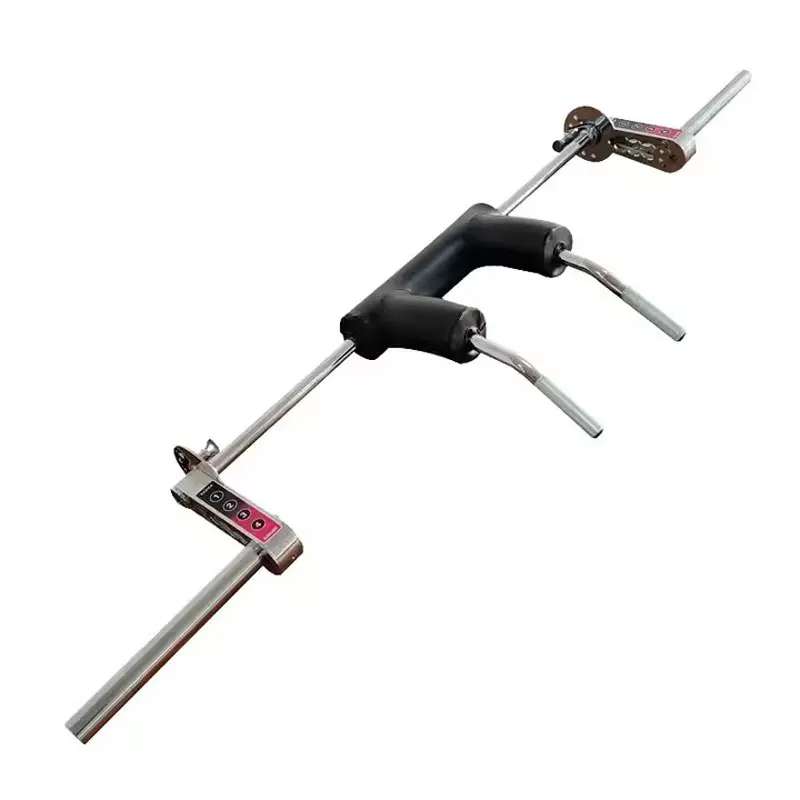
Purchasing a special barbell is an investment in your fitness journey. With so many options available, making the right choice can feel overwhelming, especially if you’re unsure what to prioritize. As a manufacturer, we at Leadman Fitness are committed to helping you make an informed decision. The type of barbell you choose will depend on your goals, the exercises you plan to perform, and your available space. A high-quality special barbell not only enhances your training experience but also ensures safety and long-term durability. In this guide, we delve deeply into the most critical factors to consider when purchasing a special barbell and offer expert advice to help you make the best choice for your needs.
Understand Your Fitness Goals
Selecting the right special barbell begins with understanding your training objectives and exercise preferences. A barbell tailored to your goals will improve performance and minimize risk.
- Olympic Weightlifting: For those focusing on dynamic Olympic lifts such as snatches or clean and jerks, it’s crucial to choose a bar with high tensile strength, superior whip, and rotating sleeves equipped with needle bearings. These features allow for smooth, controlled lifts and reduce strain on the wrists and elbows.
- Powerlifting: If your primary focus is on heavy squats, deadlifts, and bench presses, look for a bar with minimal whip and aggressive knurling. This ensures the bar can handle significant loads without excessive flex while providing a secure grip. Powerlifting bars often have center knurling for added stability during back squats.
- General Strength Training: For lifters who want versatility, a multi-purpose barbell is an excellent choice. These barbells balance features like whip and grip, making them suitable for a range of exercises, from presses to rows and squats.
- Rehabilitation and Beginners: Lighter, smaller-diameter bars, such as technique bars, are ideal for individuals new to strength training or recovering from injuries.
By defining your goals, you can focus on finding a barbell that complements your training style and supports your progression.
The quality of materials and construction directly impacts the barbell’s performance, longevity, and safety. Here’s what to look for: Investing in a high-quality bar ensures that it can withstand heavy use and last for years. The size and weight of the barbell should align with your training space and goals. Each length and weight serves a specific purpose. Proper sizing ensures both safety and efficiency in your workouts. A special barbell must fit seamlessly into your existing gym setup to maximize its usability. By ensuring compatibility, you can avoid unnecessary hassles and make the most of your investment. At Leadman Fitness, we take pride in manufacturing high-quality special barbells designed for athletes of all levels. Our products undergo rigorous testing to ensure durability, safety, and superior performance. Whether you’re an Olympic lifter, powerlifter, or general fitness enthusiast, we offer barbells tailored to your needs. From high-tensile strength materials to ergonomic knurling designs, our barbells are crafted to enhance your lifting experience and help you achieve your fitness goals. As manufacturers, we also provide detailed product specifications and customer support to guide you through your purchase. When you choose a Leadman Fitness special barbell, you’re investing in a tool designed with precision and care to elevate your training. By following this guide and prioritizing quality, compatibility, and purpose, you can confidently choose the ideal special barbell for your fitness journey.Evaluate the Build Quality
Consider the Barbell’s Size and Weight
Check Compatibility with Equipment
Why Choose Leadman Fitness Special Barbells?
Fitness Equipment That Complements a Special Barbell
A special barbell is a versatile tool, but its true potential is unlocked when paired with the right fitness equipment. By combining it with other equipment, you can expand your exercise options, target specific muscle groups, and improve overall workout efficiency. From foundational tools like benches and racks to more advanced setups like landmines and resistance bands, these combinations cater to all fitness levels and goals. Below, we explore various types of fitness equipment that work seamlessly with a special barbell to elevate your strength training.
Benches for Versatile Pressing Movements
A weight bench is one of the most essential pieces of equipment to pair with a special barbell. It provides a stable surface for performing a variety of pressing and rowing movements.
- Flat Benches: Ideal for bench presses, barbell rows, and skull crushers. The flat design allows for a stable base for strength exercises.
- Adjustable Benches: These benches allow for incline, decline, and flat settings, enabling you to target different angles for chest presses, incline rows, and shoulder presses.
- Specialized Benches: Equipment like preacher curl benches can be paired with smaller specialty barbells, such as an EZ curl bar, for targeted arm workouts.
Racks and stands are crucial for safe and effective training with a special barbell, especially when lifting heavy weights or performing compound movements. Weight plates are essential for adding resistance to your special barbell. The variety of plate options ensures compatibility with different training styles and goals. Landmine attachments add versatility to your special barbell by enabling unique rotational and pressing exercises that target the core, shoulders, and back. Adding resistance bands or chains to your special barbell introduces variable resistance, making your lifts more challenging and engaging. Platforms and mats create a safe and durable lifting environment, protecting both the equipment and the floor. Specialty attachments can enhance the functionality of your special barbell, allowing you to perform unique exercises. By pairing a special barbell with the right equipment, you can create a versatile, safe, and effective training setup that supports a wide range of exercises and fitness goals. At Leadman Fitness, we recommend assessing your space, training style, and objectives to select the equipment that complements your special barbell and elevates your workouts.Racks and Stands for Safety and Heavy Lifts
Weight Plates for Load Customization
Landmine Attachments for Dynamic Movements
Resistance Bands and Chains for Variable Resistance
Platforms and Mats for Safe Lifting
Specialty Attachments for Specific Training Goals
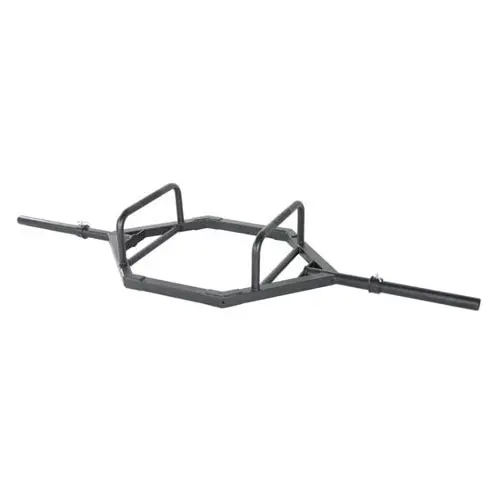
Difference Between Special Barbells and Traditional Barbells
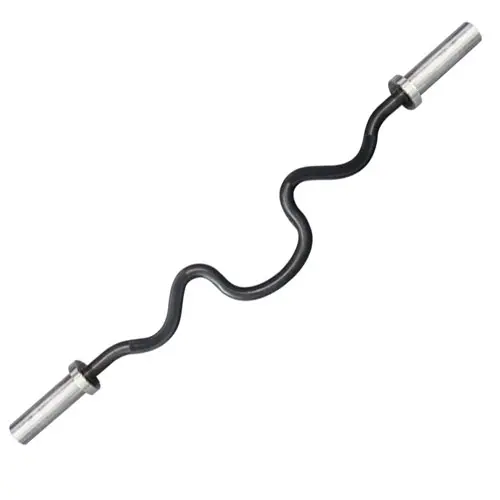
Barbells are an essential tool in strength training, but they come in many varieties, each designed with unique purposes in mind. Among them, special barbells stand out for their ability to target specific movements, muscles, and training needs that traditional barbells may not address. While traditional barbells, such as standard and Olympic barbells, serve as versatile all-around tools for strength training, special barbells introduce innovative designs to enhance performance, reduce strain, and cater to individual biomechanics. This answer will explore the differences between special barbells and traditional barbells across several aspects, such as design, purpose, versatility, and user experience.
Design: Distinct Shapes and Structures
Special barbells differ from traditional barbells primarily in their unique designs. While traditional barbells are straight and uniform, special barbells are crafted with distinct shapes to serve specific functions.
- Traditional Barbells: Straight with uniform diameter and knurling, traditional barbells come in standard and Olympic variants. Olympic barbells feature rotating sleeves and are built to meet competition standards.
- Special Barbells: These include curved, cambered, or hexagonal designs to address specific training needs. Examples include the cambered bar for shoulder relief, the trap bar for ergonomic deadlifting, and the Swiss bar for neutral grip pressing. The innovative shapes of special barbells provide solutions for athletes with mobility issues or those seeking to train in novel ways.
The purpose of each barbell type reflects their design and intended use. Special barbells are created for niche or advanced applications, whereas traditional barbells are more general-purpose. The versatility of traditional and special barbells also sets them apart. Traditional barbells offer consistency, while special barbells provide tailored solutions. Special barbells often prioritize user comfort and accessibility, making them more appealing for certain individuals. The innovation embedded in special barbells reflects their focus on solving specific training challenges. While traditional barbells are indispensable for foundational strength training, special barbells bring a layer of precision and innovation that caters to advanced lifters, athletes, and individuals with specific needs. Understanding their differences in design, purpose, and usability allows trainers and athletes to maximize their training potential and enhance their performance. Whether for rehabilitation, improving muscle imbalances, or breaking plateaus, special barbells are an excellent addition to any strength training program.Purpose: Targeted vs. General Use
Versatility: General Training vs. Specialized Applications
User Experience: Comfort and Accessibility
Innovation: A Tool for Advanced Training
FAQs about Special Barbell
What is a specialty barbell?
A specialty barbell is a type of barbell designed for specific exercises or training needs, differing from standard Olympic or powerlifting bars. These barbells often have unique shapes, weights, and grip configurations that cater to various lifting styles and goals. Common examples of specialty barbells include trap bars, safety squat bars, cambered bars, and curl bars.
Specialty barbells are particularly beneficial for targeting specific muscle groups, enhancing stability, and accommodating individual lifting mechanics. For instance, the trap bar allows lifters to adopt a more upright posture during deadlifts, reducing strain on the lower back. Similarly, safety squat bars are designed with padded shoulders and handles, making squats more accessible for those with shoulder or wrist mobility issues.
Using specialty barbells can help improve lifting technique, reduce the risk of injury, and provide a new stimulus for muscle growth. They are essential tools for strength training enthusiasts and athletes seeking to diversify their workouts and enhance performance in specific lifts.
What is the Wiggly barbell for?
The Wiggly barbell, often referred to as a “wiggle bar” or “bouncy bar,” is a type of specialty bar designed to improve coordination, stability, and strength. Its unique design allows for a flexible shaft that adds a degree of instability during lifts, requiring users to engage their core and stabilizing muscles more actively.
Wiggly barbells are commonly used in functional training and rehabilitation programs. They are particularly beneficial for athletes and individuals looking to enhance their balance and proprioception. As the bar flexes and moves during exercises, users must stabilize their movements, which can improve overall functional strength and athletic performance.
Exercises performed with a Wiggly barbell include squats, deadlifts, presses, and various functional movements. The added instability challenges the muscles in new ways, promoting greater muscle activation and engagement. This type of barbell can also be helpful for those recovering from injuries, as it encourages controlled movements and can be adapted to individual fitness levels.
Are there different types of barbells?
Yes, there are various types of barbells designed for different purposes and exercises. Each type has unique features that cater to specific training needs. Here are some of the most common types:
Olympic Barbell: The standard barbell used in Olympic weightlifting, typically weighing 20 kg (44 lbs) for men and 15 kg (33 lbs) for women. Olympic barbells are designed to handle heavy loads and often feature rotating sleeves for smoother lifts.
Powerlifting Barbell: Similar to Olympic barbells but designed specifically for powerlifting competitions. These bars are typically stiffer and have a different knurling pattern to accommodate squats, bench presses, and deadlifts.
Trap Bar: Also known as a hex bar, this barbell allows lifters to stand inside the frame, promoting a more upright lifting posture and reducing strain on the back.
Safety Squat Bar: This bar features padded shoulders and handles, allowing for a more comfortable squat position, particularly for those with shoulder or wrist issues.
Cambered Bar: A barbell with a curved design that allows for deeper squats and different muscle engagement compared to traditional bars.
Curl Bar: Designed specifically for bicep curls, this bar allows for a comfortable grip and reduces strain on the wrists during lifting.
What is ghost riding a barbell?
Ghost riding a barbell refers to the practice of allowing the barbell to roll off the lifter’s back or body during a lift, particularly in exercises like squats or bench presses. This action can occur when a lifter loses control of the barbell, often due to poor form, insufficient grip, or fatigue.
While the term may sound humorous, ghost riding can be dangerous and lead to injury if not done carefully. It typically happens when a lifter attempts to drop or transition the weight without maintaining control, potentially resulting in the barbell falling or rolling unexpectedly.
To prevent ghost riding, it is crucial to maintain proper form throughout the lift and engage the core and stabilizing muscles effectively. Lifters should also ensure they are using the appropriate weight for their fitness level to minimize the risk of losing control. Proper use of safety equipment, such as spotters or safety bars, is also recommended, especially when lifting heavy weights. Practicing good lifting techniques and being mindful of your body mechanics can help you avoid ghost riding and keep your workouts safe and effective.
Are Olympic bars 55 pounds?
Not all Olympic bars weigh 55 pounds, but many do. A standard men’s Olympic barbell is typically 7 feet long and weighs 20 kilograms (44 pounds). However, certain specialized bars, such as powerlifting bars or bars used for Olympic weightlifting competitions, may weigh 25 kilograms (55 pounds). Women’s Olympic bars are generally shorter, lighter (15 kg or 33 pounds), and have a smaller diameter for easier grip. When determining the weight of an Olympic bar, check the manufacturer’s specifications to ensure accuracy. Gym bars labeled “Olympic” might not adhere strictly to competition standards and could vary in weight.
Can you bench press with a 7ft bar?
Yes, you can bench press with a 7ft bar. A 7ft Olympic bar is the standard for bench pressing in most gyms and competitions due to its length, balance, and weight distribution. The longer bar provides more stability, especially when adding heavier weights. It typically fits standard bench press racks and ensures that your grip is wide enough for an effective press. The 7ft length is ideal for a variety of exercises beyond bench pressing, such as squats, deadlifts, and rows, making it a versatile option. However, it may feel cumbersome for smaller individuals or those with limited space.
Can you bench with a 6ft bar?
Yes, you can bench press with a 6ft bar, but it depends on the bar’s diameter, sleeve length, and weight capacity. A 6ft bar can be suitable for bench pressing if it fits securely on your bench rack and can hold the required weight for your workout. However, a 6ft bar often has shorter sleeves than a 7ft bar, which limits how many weight plates you can add. This may be a drawback for advanced lifters. Additionally, some 6ft bars are designed for lighter exercises and might not support heavy weights. Check the specifications before use.
Is a 5ft barbell good for bench press?
A 5ft barbell can be used for bench pressing, but it has limitations. These shorter bars are usually lighter, with a reduced weight capacity and shorter sleeves for plates. They are best suited for beginners, those working in small spaces, or people lifting light weights. A 5ft bar may not provide enough width for a comfortable grip or stability during heavy bench presses, particularly for taller individuals or advanced lifters. Most bench press racks are designed for 6ft or 7ft bars, so a 5ft bar might not fit securely on the rack.
How heavy is a 5 ft Olympic bar?
A 5ft Olympic bar typically weighs between 25 and 35 pounds (11-16 kg). However, its exact weight depends on the brand and design. Unlike standard bars, Olympic bars are built to hold Olympic-sized plates and have rotating sleeves to reduce wrist strain during lifts. These bars are shorter and lighter than standard 7ft Olympic bars, making them more convenient for smaller spaces or lighter workouts. Always confirm the weight and load capacity with the manufacturer before use.
How heavy is a 6ft Olympic bar?
A 6ft Olympic bar generally weighs between 30 and 40 pounds (13-18 kg), depending on its design and manufacturer. Like a 7ft Olympic bar, it has rotating sleeves for smooth plate movement but is shorter, making it easier to handle in small spaces. The load capacity is usually less than that of a 7ft bar, so it’s more suitable for beginner to intermediate lifters. Before use, ensure the bar fits your equipment and is appropriate for your lifting goals.
How much does a CAP 7ft barbell weigh?
A CAP 7ft barbell typically weighs 45 pounds (20 kilograms). CAP produces a range of barbells, including standard and Olympic versions, so double-check the product specifications. A 7ft bar is the standard length for many exercises, including bench presses, deadlifts, and squats. CAP barbells are popular for their affordability and durability, but their weight capacity and whip (flexibility) may vary, making them more suitable for general fitness than competitive lifting.
Is an EZ curl bar worth it?
An EZ curl bar is worth it if you want to target your biceps and triceps while reducing strain on your wrists and elbows. The bar’s curved design provides a more natural grip, which can alleviate joint discomfort during curls, skull crushers, or triceps extensions. It’s a great addition for lifters focusing on arm development. While it’s less versatile than a straight bar, it can complement your routine by offering variety. However, if your budget or space is limited, consider whether its specific benefits align with your goals.
Is an Olympic barbell worth it?
An Olympic barbell is worth it for most lifters due to its durability, versatility, and compatibility with Olympic-sized plates. Built to withstand heavy loads, Olympic bars are essential for serious strength training, powerlifting, or weightlifting. They feature rotating sleeves that reduce strain on your wrists, making them ideal for dynamic lifts like snatches or clean and jerks. While more expensive than standard barbells, their quality and longevity make them a solid investment. If you’re committed to weight training, an Olympic bar is a worthwhile addition to your gym setup.
Is the bar at the gym 45 pounds?
In most gyms, the standard barbell used for exercises like bench presses, squats, and deadlifts weighs 45 pounds (20 kilograms). This applies to 7ft Olympic bars, which are the most common in commercial gyms. However, some specialty bars, such as women’s Olympic bars (33 pounds) or training bars (lighter than 45 pounds), may also be available. Always confirm the bar’s weight before lifting, especially in unfamiliar gyms, to ensure accurate load calculation.
What is the skinny barbell for?
The skinny barbell, often referred to as a “technique bar” or “training bar,” is primarily designed for beginners or those practicing form and technique. These bars are usually lighter than standard Olympic or powerlifting barbells, making them easier to handle while focusing on proper lifting mechanics. Skinny barbells are also useful for mobility work or warm-ups, as their reduced diameter makes them easier to grip. They are commonly used for exercises like curls, presses, or light squats. In some cases, the skinny barbell may be part of a specialty set, such as smaller-diameter bars for children or rehabilitation purposes.
What is the squiggly weight bar called?
The squiggly weight bar is called an EZ curl bar. Its signature curved design is tailored to reduce strain on the wrists and elbows during curling or triceps exercises. By offering multiple grip angles, the EZ curl bar allows lifters to choose the most comfortable hand position, making it a popular choice for bicep curls, reverse curls, and skull crushers. The ergonomic design also minimizes the risk of injury and improves joint comfort, especially for lifters with wrist issues. While it’s not as versatile as a straight barbell, the EZ curl bar is a great addition for arm-focused workouts.
What is the Swiss barbell used for?
The Swiss barbell, also called a multi-grip bar, is designed to provide multiple neutral grip options for a variety of exercises. This specialty bar is excellent for pressing movements like bench presses, shoulder presses, and triceps extensions. The neutral grip reduces strain on the shoulders and wrists, making it a good choice for those with joint issues or recovering from injuries. The Swiss bar is also commonly used for rows, curls, and even hammer grip pull-ups. Its versatility allows lifters to target muscles in different ways while minimizing stress on vulnerable joints.
What is the twisted barbell called?
The twisted barbell is typically referred to as an EZ curl bar due to its wavy or curved design. It is specifically shaped to accommodate a more natural grip position, which helps reduce wrist strain during exercises like bicep curls or triceps extensions. The “twisted” or angled grip positions make it easier to isolate specific muscles and perform exercises with greater comfort. This bar is especially beneficial for people who experience discomfort with traditional straight bars during arm-focused workouts.
What is the zig zag bar for?
The zig zag bar, also known as the EZ curl bar, is designed for exercises that target the arms, such as bicep curls, triceps extensions, and upright rows. The unique zig zag design provides multiple grip angles, allowing lifters to find a comfortable and joint-friendly hand position. This reduces strain on the wrists and elbows, making it a safer option for those prone to joint pain. The zig zag design also allows for better muscle isolation during arm exercises, contributing to improved strength and development.
What length barbell for landmine?
For landmine exercises, a 7ft Olympic barbell is typically the best choice due to its length and weight distribution. The longer bar provides greater stability when placed in the landmine attachment, allowing for a wide range of exercises, such as landmine presses, rows, and squats. However, if space is limited, a 6ft bar can also work, as long as it fits securely in the landmine holder and is compatible with Olympic-sized plates. Avoid using shorter bars, such as 5ft barbells, as they may not offer sufficient leverage or balance for landmine movements.
What size bar is best for deadlifts?
The best bar for deadlifts is typically a 7ft Olympic bar, weighing 45 pounds and built to withstand heavy loads. For competitive powerlifters, a “deadlift bar” is often preferred. Deadlift bars are slightly longer and thinner than standard bars, with extra whip (flexibility) to assist with the lift. This design allows for greater bar flex at the start of the pull, making it easier to lift heavy weights off the ground. For general gym-goers, a standard 7ft barbell is ideal due to its versatility and compatibility with other lifts.
Is the Olympic bar 6ft or 7ft?
Olympic barbells are typically 7 feet long (2.2 meters). This length is standard for competition and training purposes because it accommodates a wide range of exercises, including squats, deadlifts, and bench presses, while offering enough length to fit on competition-standard squat racks and bench setups. Some shorter Olympic-style bars (6 feet or less) are also available, but these are usually designed for smaller spaces or for individuals who don’t need the full length. A true 7-foot Olympic bar weighs 20 kilograms (44 pounds) and features rotating sleeves to reduce torque on the wrists during lifts. These bars are highly versatile and are built to handle heavy loads, making them the go-to choice for powerlifting, weightlifting, and CrossFit training. Shorter variants are not considered regulation Olympic bars and might lack the sleeve rotation or standardized weight and diameter.
What are bendy barbells for?
Bendy barbells, often called whip bars, are designed to flex and bend under heavy loads. This intentional flexibility helps athletes take advantage of the “whip” effect during dynamic movements, such as cleans, snatches, or squats. The bar’s bending allows lifters to generate momentum at the bottom of a lift, making transitions smoother and reducing strain on joints. These bars are most common in Olympic weightlifting and high-rep strength training.
Additionally, bendy bars can provide shock absorption, which makes them beneficial for athletes recovering from injuries. Some bendy barbells, like the Tsunami Bar, are specifically engineered with flexible materials to create more instability, forcing lifters to engage stabilizing muscles. This feature can improve balance, core strength, and overall stability during lifting. Overall, bendy barbells serve a mix of performance enhancement and injury prevention in strength and conditioning programs.
What is a cambered barbell used for?
A cambered barbell has a curved design, which shifts the weight distribution lower than a standard bar. This design is primarily used for squats, good mornings, and other lower-body exercises. The curved shape allows lifters to maintain a more upright torso position, reducing strain on the shoulders and elbows while improving comfort during squats. It is particularly useful for individuals with limited shoulder mobility or those recovering from injuries.
The cambered barbell also challenges stability because the weight hangs slightly lower than a straight bar. This added instability forces lifters to engage more stabilizing muscles in the core and upper body, making it an excellent tool for building strength and balance. In powerlifting and strength training, cambered bars help lifters break through plateaus by varying the movement pattern and activating muscles in a slightly different way than traditional barbells.
What is a fancy bar called?
A “fancy bar” is often referred to as a specialty barbell. These bars deviate from the traditional straight design of standard barbells to accommodate specific exercises or target unique muscle groups. Examples of fancy bars include the Swiss bar (multi-grip bar), which has multiple neutral hand positions to reduce stress on the shoulders during pressing exercises, and the safety squat bar, which has padded handles for added comfort during squats.
Other specialty bars like the trap bar (or hex bar) are used for deadlifts and shrugs while minimizing stress on the lower back. Specialty bars are called “fancy” because they add versatility to training routines and are often crafted with specific ergonomic or biomechanical benefits. They’re favored by athletes, powerlifters, and bodybuilders looking to address limitations, recover from injuries, or target muscles more precisely.
What is a log barbell for?
A log barbell, also called a log press bar, is specifically designed for strongman training and competitions. It has a thick, cylindrical shape and neutral grip handles embedded inside the log, making it ideal for overhead pressing and other pressing variations. The neutral grip reduces stress on the wrists and shoulders, making it safer for heavy lifting.
Log barbells are typically much larger and heavier than standard barbells, with hollow or solid log designs that simulate the traditional strongman task of lifting and pressing large, cumbersome objects. Training with a log barbell builds raw strength, coordination, and functional power. It also emphasizes the triceps, deltoids, and upper chest during pressing movements. This bar is a staple in strongman events like the log clean and press, where competitors lift the log from the floor to their shoulders and then press it overhead.
What is a tsunami barbell for?
A tsunami barbell is a flexible bar made of composite materials designed to create oscillating forces during lifts. Unlike traditional barbells, it bends significantly when loaded with weights, creating instability that forces lifters to engage their stabilizing muscles more intensely. This instability targets core strength, balance, and joint stability while also challenging coordination.
Tsunami bars are often used in rehabilitation settings or to prevent injuries because the instability encourages safer, more controlled movements. They’re particularly effective for dynamic exercises like bench presses, squats, and overhead presses, as they require precise technique to maintain balance. Athletes also use tsunami bars to improve explosive power, as the oscillations can mimic the demands of real-world sports movements. The bar’s unique properties make it an innovative tool for building functional strength and improving overall athletic performance.
What is special bar quality?
Special bar quality (SBQ) refers to the high-grade steel used in manufacturing specialty and Olympic barbells. This steel is engineered to withstand heavy loads, repeated impact, and bending without compromising durability or performance. Bars with special bar quality have high tensile strength, typically ranging from 150,000 to 230,000 PSI (pounds per square inch), which allows them to resist permanent deformation under extreme weights.
SBQ also includes features like precision knurling for grip, corrosion-resistant coatings (e.g., chrome or cerakote), and smooth, rotating sleeves with needle bearings or bushings. These qualities ensure that the bar performs consistently, whether used for powerlifting, Olympic lifting, or general strength training. Special bar quality is crucial for safety and reliability, particularly in competitive settings where bars are subject to intense usage and heavy weights.
What is the difference between Olympic barbells and regular barbells?
Olympic barbells are designed for competition and are typically longer (7 feet), heavier (20 kg/44 lbs for men, 15 kg/33 lbs for women), and have rotating sleeves to reduce stress on the wrists during dynamic lifts. They also feature higher tensile strength to withstand heavy loads without bending permanently. Olympic bars are ideal for lifts like snatches, clean and jerks, and squats.
Regular barbells, often used in casual settings, are shorter (5-6 feet), lighter, and lack rotating sleeves. They are not designed to handle the same extreme weights and are better suited for basic lifts like bench presses or bicep curls. Additionally, regular bars often have less aggressive knurling and lower-quality steel, making them less durable. Olympic bars prioritize performance, durability, and precision, while regular bars focus on affordability and general fitness use.
What is the EZ bar for?
An EZ bar is a shorter barbell with a zigzag shape designed for curling and tricep extension exercises. The ergonomic design provides a more natural wrist position compared to straight bars, reducing strain on the wrists and elbows during exercises like bicep curls, skull crushers, and upright rows.
The EZ bar’s angled grips make it particularly effective for isolating the biceps and triceps while minimizing discomfort or joint stress. It is also commonly used for lighter accessory lifts in strength training or bodybuilding routines. The bar typically weighs around 15-25 pounds, making it easy to incorporate into a variety of exercises. The EZ bar is an excellent option for lifters looking to build arm strength and muscle definition while maintaining joint health.
What is the first specialty barbell?
The first specialty barbell is often considered the cambered bar, developed to assist lifters with limited shoulder mobility. Its curved design made it easier for lifters to hold the bar during squats without straining their shoulders. Over time, specialty barbells have evolved into a wide variety of designs, each tailored to specific training goals or biomechanical needs.
The cambered bar likely originated from the early 20th century as strength training and powerlifting began to grow in popularity. It was followed by other specialty bars like the trap bar and the safety squat bar, which addressed additional challenges such as back and knee strain. These early specialty bars laid the foundation for today’s diverse range of innovative equipment, helping athletes and lifters train more effectively while reducing the risk of injury.
